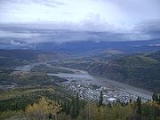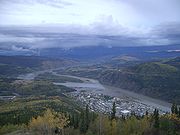
Tr'ochëk
Encyclopedia

Han (North American people)
The Han are a Northern Athabascan people who speak the Hän language. Only a handful of fluent speakers remain. Their traditional land centered around a heavily forested area around the Yukon River straddling what is now the Alaska-Yukon Territory border...
fishing camp at the confluence of the Klondike River
Klondike River
The Klondike River is a tributary of the Yukon River in Canada that gave its name to the Klondike Gold Rush. The Klondike River has its source in the Ogilvie Mountains and flows into the Yukon River at Dawson City....
and Yukon River
Yukon River
The Yukon River is a major watercourse of northwestern North America. The source of the river is located in British Columbia, Canada. The next portion lies in, and gives its name to Yukon Territory. The lower half of the river lies in the U.S. state of Alaska. The river is long and empties into...
. The site is owned and managed by the Tr’ondëk Hwëch’in First Nation
Tr’ondëk Hwëch’in First Nation
The Tr’ondëk Hwëch’in is a First Nations located in the central Yukon, Canada. Its main population centre is Dawson City, Yukon.Many of today’s Tr’ondëk Hwëch’in, or people of the river, are descendants of the Hän-speaking people who have lived along the Yukon River for thousands of years...
, and is operated by the First Nation's Department of Heritage.
In the late 19th century Tr'ochëk was the camp of Chief Isaac, the leader of the Tr'ondek Hwech'in during the Klondike Gold Rush
Klondike Gold Rush
The Klondike Gold Rush, also called the Yukon Gold Rush, the Alaska Gold Rush and the Last Great Gold Rush, was an attempt by an estimated 100,000 people to travel to the Klondike region the Yukon in north-western Canada between 1897 and 1899 in the hope of successfully prospecting for gold...
. The Tr'ondek people used this site primarily in the summer, hunting moose
Moose
The moose or Eurasian elk is the largest extant species in the deer family. Moose are distinguished by the palmate antlers of the males; other members of the family have antlers with a dendritic configuration...
in the flats across the Klondike and fishing for salmon
Salmon
Salmon is the common name for several species of fish in the family Salmonidae. Several other fish in the same family are called trout; the difference is often said to be that salmon migrate and trout are resident, but this distinction does not strictly hold true...
during their migration up the Yukon.
Tr'ochek lies on the upstream flat, an alluvial
Alluvium
Alluvium is loose, unconsolidated soil or sediments, eroded, deposited, and reshaped by water in some form in a non-marine setting. Alluvium is typically made up of a variety of materials, including fine particles of silt and clay and larger particles of sand and gravel...
deposition of the Klondike River, at the river confluence. Dawson City
Dawson City, Yukon
The Town of the City of Dawson or Dawson City is a town in the Yukon, Canada.The population was 1,327 at the 2006 census. The area draws some 60,000 visitors each year...
is directly north of the site, just across the Klondike.
The river flat has a mixture of poplar trees, alder
Alder
Alder is the common name of a genus of flowering plants belonging to the birch family . The genus comprises about 30 species of monoecious trees and shrubs, few reaching large size, distributed throughout the North Temperate Zone and in the Americas along the Andes southwards to...
and willow
Willow
Willows, sallows, and osiers form the genus Salix, around 400 species of deciduous trees and shrubs, found primarily on moist soils in cold and temperate regions of the Northern Hemisphere...
bushes, with open grassy meadows. The steep hillside behind the site is covered with vegetation typical of a northern exposure boreal forest
Taiga
Taiga , also known as the boreal forest, is a biome characterized by coniferous forests.Taiga is the world's largest terrestrial biome. In North America it covers most of inland Canada and Alaska as well as parts of the extreme northern continental United States and is known as the Northwoods...
- thick moss
Moss
Mosses are small, soft plants that are typically 1–10 cm tall, though some species are much larger. They commonly grow close together in clumps or mats in damp or shady locations. They do not have flowers or seeds, and their simple leaves cover the thin wiry stems...
, spruce
Spruce
A spruce is a tree of the genus Picea , a genus of about 35 species of coniferous evergreen trees in the Family Pinaceae, found in the northern temperate and boreal regions of the earth. Spruces are large trees, from tall when mature, and can be distinguished by their whorled branches and conical...
, and small birch
Birch
Birch is a tree or shrub of the genus Betula , in the family Betulaceae, closely related to the beech/oak family, Fagaceae. The Betula genus contains 30–60 known taxa...
groves. On the bench above the flat, mining activity has stripped away both vegetation and soil, leaving a fringe of the original spruce forest along the edge of the river bluffs.
The gold rush was a period of great disruption for the Tr'ondek Hwech'in. Thousands of stampeders overwhelmed them at their summer camp. To avoid the worst excesses of this time, the Tr'ondek Hwech'in made arrangements, with the assistance of the Anglican Church
Anglican Church of Canada
The Anglican Church of Canada is the Province of the Anglican Communion in Canada. The official French name is l'Église Anglicane du Canada. The ACC is the third largest church in Canada after the Roman Catholic Church and the United Church of Canada, consisting of 800,000 registered members...
and the Royal Canadian Mounted Police
Royal Canadian Mounted Police
The Royal Canadian Mounted Police , literally ‘Royal Gendarmerie of Canada’; colloquially known as The Mounties, and internally as ‘The Force’) is the national police force of Canada, and one of the most recognized of its kind in the world. It is unique in the world as a national, federal,...
, to move a few kilometres downriver to a site known as Moosehide.
After the Tr'ondek Han relocation to Moosehide (64°05′40"N 139°26′12"W), Tr'ochek was used by the non-native newcomers for a series of urban and industrial activities. Several bridges connected the site to Dawson City and until the 1910s, Klondike City, as the site became known, remained a fairly active part of the Dawson urban area. Later, as the newcomer population dwindled, the site was used for a time for market gardening. First Nation people began resettling the site in the 1950s.
In the early 1990s mining activity on the site instigated a lawsuit by the Tr'ondek Hwech'in challenging Canada's
Government of Canada
The Government of Canada, formally Her Majesty's Government, is the system whereby the federation of Canada is administered by a common authority; in Canadian English, the term can mean either the collective set of institutions or specifically the Queen-in-Council...
right to issue mining claims
Mineral rights
- Mineral estate :Ownership of mineral rights is an estate in real property. Technically it is known as a mineral estate and often referred to as mineral rights...
on unsurrendered Indian lands. The Tr'ondek Hwech'in reaffirmed their ownership of the site in their land claim final agreement in 1998, and designated it as a heritage site. It was subsequently designated as a National Historic Site of Canada on July 19, 2002.

